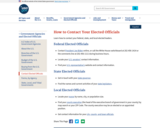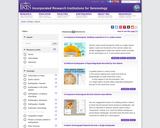
Find your congressmen
- Subject:
- Social Science
- Social Studies
- Material Type:
- Primary Source
- Date Added:
- 09/07/2022

Find your congressmen

This resource is a free, downloadable audio file of short music clips to use for instruction.

This resource is a free, downloadable audio file of short music clips to use for instruction.

This resource is a free, downloadable audio file of short music clips to use for instruction.

This resource is a free, downloadable audio file of short music clips to use for instruction.

I Have a Dream Speech. Martin Luther King's Address at March on Washington, August 28, 1963. Washington, D.C.

A recording and transcript of Martin Luther King Jr.'s celebrated "I Have a Dream" speech, delivered on Aug. 28, 1963, on the steps of the Lincoln Memorial.

This resource is a free, downloadable audio file of short music clips to use for instruction.

This resource is a free, downloadable audio file of short music clips to use for instruction.

Website with a collection of resources, videos, lessons, lectures, public displays, etc. all regarding earthquakes.

This resource is a free, downloadable audio file of short music clips to use for instruction.

This resource is a free, downloadable audio file of short music clips to use for instruction.

View images from the locations of famous Civil War battles, such as First Battle of Bull Run in 1861, near Manassas Junction, Virginia, and siege of Vicksburg, Mississippi, in 1863. The first and second battles of Bull Run, in 1861 and 1862, were Confederate victories and a blow to the Union Army’s confidence. The Union victory at Vicksburg, a Confederate stronghold on the Mississippi River, would divide and weaken the Confederacy. The Civil War was fought in 10,000 locations across the United States.

View images of Jefferson, Monticello, and the Declaration of Independence. Thomas Jefferson (1743-1846) was the third president of the United States of America, and served two terms between the years 1801-1809. He was a founding father of the country, and author of the Declaration of Independence. The son of a Virginia planter, Jefferson was educated at the College of William & Mary in Williamsburg, Virginia. As president, he created the military academy at West Point; he expanded the size of the country with the Louisiana Purchase, and commissioned Lewis & Clark to explore the western United States.

Students match primary sources to the reasons individuals immigrated to the United States.

Earl Ubell is a pioneer among science and health writers in America. After a long, distinguished career at The New York Herald Tribune from 1943 to 1966, he went on to work at both CBS and NBC News. Prominent in the emerging scientific writing community in the 1950s and early 1960s, he was a recipient of the Lasker Medical Journalism Award 1957. Milton Stanley Livingston was a leading physicist in the field of magnetic resonance accelerators. Working first with professor Ernest O. Lawrence at the University of California, Livingston was instrumental in the development of the Berkeley cyclotron. Moving to Cornell in 1938, Livingston was part of the core group who established nuclear physics as a field of study. Choosing to stay with the Cornell cyclotron rather than follow colleagues onto the Manhattan Project, Livingston was involved in the production of radioisotopes for medical purposes. At the time of this interview, Livingston was director of the Cambridge Electron Accelerator, a joint project of Harvard University and MIT.In this program segment Louis Lyons quizzes Earl Ubell about the lack of public knowledge and the perception of the nuclear bomb, while pressing Professor Livingston to explain exactly what nuclear fallout is, and the danger it presents.

Ben, an enslaved miller at Mount Vernon, discusses freedom. In a reenactment of him thinking aloud, he considers what his life might be like if he runs away from Mount Vernon and gains his freedom as compared to his current life as George Washington's miller.

Interview with Linda Brown Smith on her family’s involvement in the Brown vs. Board of Education lawsuit (includes written transcript). Discussion centers on her experiences in Kansas's segregated schools and her family's involvement in the Brown vs. Board of Education lawsuit.

At age twenty-seven, physicist Philip Morrison joined the Manhattan Project, the code name given to the U.S. government's covert effort at Los Alamos to develop the first nuclear weapon. The Manhattan Project was also the most expensive single program ever financed by public funds. In this video segment, Morrison describes the charismatic leadership of his mentor, J. Robert Oppenheimer, and the urgency of their mission to manufacture a weapon 'which if we didn't make first would lead to the loss of the war." In the interview Morrison conducted for War and Peace in the Nuclear Age: 'Dawn,' he describes the remote, inaccessible setting of the laboratory that operated in extreme secrecy. It was this physical isolation, he maintains, that allowed scientists extraordinary freedom to exchange ideas with fellow physicists. Morrison also reflects on his wartime fears. Germany had many of the greatest minds in physics and engineering, which created tremendous anxiety among Allied scientists that it would win the atomic race and the war, and Morrison recalls the elaborate schemes he devised to determine that country's atomic progress. At the time that he was helping assemble the world's first atomic bomb, Morrison believed that nuclear weapons 'could be made part of the construction of the peace.' A month after the war, he toured Hiroshima, and for several years thereafter he testified, became a public spokesman, and lobbied for international nuclear cooperation. After leaving Los Alamos, Morrison returned to academia. For the rest of his life he was a forceful voice against nuclear weapons.

Per Utah Code 53G-10-402 parental consent is required prior to instruction in this content.
Utah Department of Health site for Intimate Partner Violence. Includes data, toolkits, resources, warning signs, posters, and more.